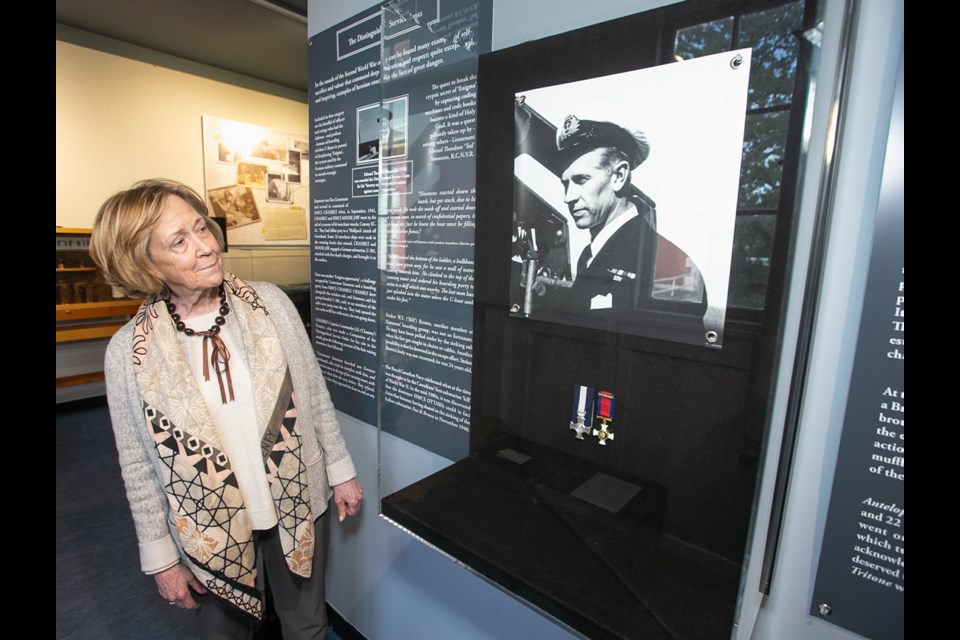The daughter of Victoria war hero Cmdr. Ted Simmons remains disappointed her father’s medals were never repatriated, despite a new military-museum exhibit that grants Simmons top honours.
“I think what the museum has done is amazing,” said Deborah Cotton of Toronto. “But I still struggle with why someone would ever sell something that really belongs here.”
In a family dispute, Simmons’ seven Second World War medals, including the Distinguished Service Cross and Distinguished Service Order, were auctioned in England. A Canadian effort to raise the money failed.
Cotton was an honoured guest at the CFB Esquimalt Naval and Military Museum on Friday for the ceremonial ribbon cutting of a new exhibit — Hero Warship: HMCS Beacon Hill and Her Daring Commander.
The exhibit, open until Sept. 30, offers viewers glimpses of the heroic efforts made in the Second World War by Canada and Canadians.
In just a few years, Canada was building and launching warships such as HMCS Beacon Hill. The frigate was the first Second World War naval vessel to carry a Victoria element in its name.
HMCS Beacon Hill was built at the now-defunct Yarrow’s shipyard in Esquimalt and launched in 1943. In her wartime career, the Beacon Hill would be escort to 79 convoys.
The vessel would remain with the Canadian Navy after the war was over. Following several refits, she was decommissioned in 1967.
Meanwhile, the Second World War saw Simmons and people like him transform. He went from an interior decorator with Standard Furniture in Victoria to sinking U-boats in the North Atlantic and commanding several ships. By the war’s end, he was the most decorated member of the Royal Canadian Naval Volunteer Reserve to serve in the North Atlantic.
A Hollywood wartime movie, Corvette K-225, starring Randolph Scott, was partly based on Simmons’ wartime exploits. Those included the boarding of a sinking U-Boat in an attempt to retrieve secret code machines used in Nazi war communications. The retrieval was unsuccessful, but Simmons was decorated for the effort.
After the war, Simmons went to work for Distillers Corp. Canada. He died in 1988 at the age of 78 in England, where he had remarried after the death of his first wife.
At the opening of the exhibit honouring Simmons and HMCS Beacon Hill, Cotton, now 75, told the guests she grew up hearing other people call her father a hero. But he told his daughters very little.
“My understanding of my father was when you attain such heights, as he did when he was young, it can be difficult to navigate the rest of your life,” she said.
But Cotton gave credit to her father for working and supporting his wife and three daughters in Canada.
She said her best remembrance of Simmons’ wartime experiences was him telling her she was entitled to HMCS Beacon Hill’s own ship’s bell.
It’s an honour bestowed on the first child to be christened on board a ship, as Cotton was on Beacon Hill on June 10, 1945, in Halifax.
“Sadly, I understand the location of the original ship’s bell is unknown,” she said. ‘But the museum now has on display the second bell.”
“You can also see my christening cup,” said Cotton.
Histories compiled by the museum say the initial thought was to name the Beacon Hill HMCS Victoria. But the idea was dropped when the British Royal Navy complained it already had an HMS Victorious. Instead, she was named after a prominent local landmark.
The Victoria community would adopt the ship as its own, using her name and pictures in various morale-boosting drives.
Cmdr. Cory Foreman, CFB Esquimalt administrative officer, said naming warships after places and landmarks in Canada makes for special relationships between ships’ crews and communities.
“It allows sailors to take a piece of home with them when they deploy, no matter how far they go or whatever dangers they face,” said Foreman.
Beacon Hill, “is an excellent example of that unique relationship between a warship and her city,” he said.



